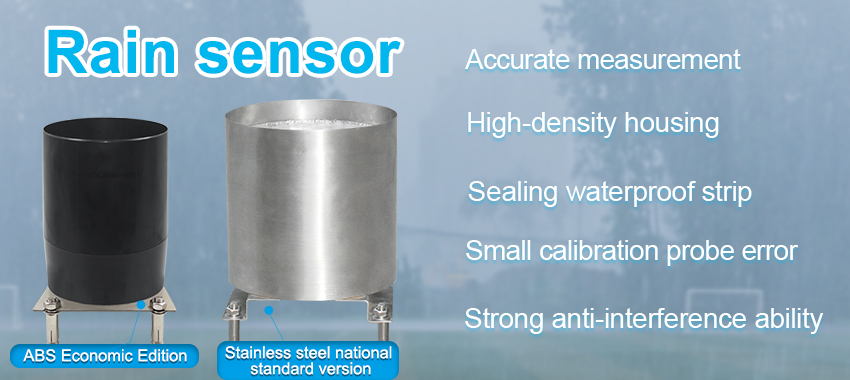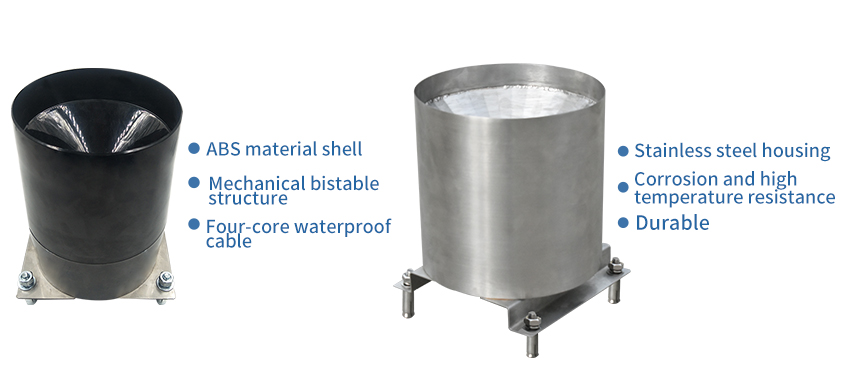Summary:
The tipping bucket rain sensor is a kind of hydrological and meteorological instrument, which is used to measure the natural rainfall and convert the rainfall into digital information output in the form of switching quantity, so as to meet the needs of information transmission, processing, recording and display. The 0.2, 0.5 mm tip bucket rain gauge developed successfully in China can be used for long-term rainfall data collection of national hydrological and meteorological stations.
The instrument is compatible with the recording or display part, which can transmit, display and record rainfall data by wire. It can be used as the sensor of telemetering rain situation and flood reporting in special stations. It is widely used in hydrology stations in China, and exported in bulk to eastern and western countries, and won the national utility model patent. The type of rain gauge has been tested and evaluated by the industrial Development and equipment Department of China Meteorological Administration, which proves that its performance is stable and its performance has reached the international advanced level.

Working principle:
The rainwater collected by the nozzle, through the upper cylinder (funnel), is injected into the metering bucket — the bucket is divided into two equal volume triangular chambers with the middle baffle by injection molding of engineering plastic. It is a mechanical bistable structure. When one chamber receives water, the other chamber is in a waiting state. When the volume of rainwater received reaches the predetermined value of 0.2mm, it is tipped over due to gravity and is in a waiting state, while the other chamber is in the working state of receiving water. When the water volume reaches the predetermined value, it is overturned and in a waiting state. Magnetic steel is arranged on the side wall of the tip bucket, which is scanned from the dry tongue spring tube when the tip bucket is turned, so that the dry tongue spring tube is on and off. That is, when the bucket is turned over once, the dry tongue reed tube is connected to send a switching signal (pulse signal).
Background:
Precipitation is an important meteorological element, and precipitation observation is of great significance to meteorology, hydrology, ocean and environment observation as well as aviation and railway traffic safety. Rain gauge is an important instrument to observe precipitation, and its accuracy is directly related to the reliability of the measured data, especially in the effect of artificial rainfall testing and meteorological research, the accuracy of its measurement is particularly important. To ensure the accuracy and reliability of the rain gauge, it is necessary to calibrate the rain gauge. At present, the calibration of rain gauges mainly uses standard containers or high-precision tipping bucket rain gauges, and there are also manual methods to calibrate them through measuring cups. The whole process is inefficient and easy to cause artificial errors, so a calibration instrument that can automatically produce the required rainfall is needed.
Working principle:
Tip bucket rain sensor is a remote rainfall measuring instrument composed of inductor and signal recorder. The inductor is composed of water bearing device, upper tip bucket, metering tip bucket, counting tip bucket, dry spring switch, etc. The recorder consists of a counter, a recording pen, a recording clock, a control circuit board and so on. Its working principle is: the rain water enters the water bearing device from the upper end, falls into the water receiving funnel, and flows into the tipping bucket through the funnel mouth. When the volume of water reaches a certain height (such as 0.01 mm), the tipping bucket loses its balance and turns over. And each time the bucket dump, switch on the circuit, to convey a pulse signal to the recorder, recorder control recording pen will record rainfall, so reciprocating can be measured down the rainfall process.

The tipping bucket rain sensor is widely used because of its high degree of automation, strong timeliness of obtaining precipitation and easy preservation and transmission of rainfall data. In addition, the tip gauge is particularly convenient for automatic weather station because it is suitable for digital methods. The tip gauge measures rainfall intensity in a range not greater than 4.0 mm/min with a minimum resolution of 0.1 mm.
With strong anti-interference ability, outdoor design, high measurement accuracy, large storage capacity, convenient networking, automatic unattended, stable operation and so on.
Features:
(1) The tipping bucket rain sensor is used to measure the natural rainfall and convert the rainfall into digital information output in the form of switching quantity to meet the needs of information transmission, processing, recording and display, etc.
(2) tip bucket rainfall sensor is suitable for meteorological station, hydrologic stations, agriculture and forestry, national defense and other relevant departments used for telemetry liquid precipitation, precipitation intensity, precipitation start and end time.
(3) Used for flood control, water supply dispatching, water situation management of power station and reservoir for the purpose of hydrological automatic measurement and reporting system, automatic field measurement and reporting station, precipitation measurement sensor.